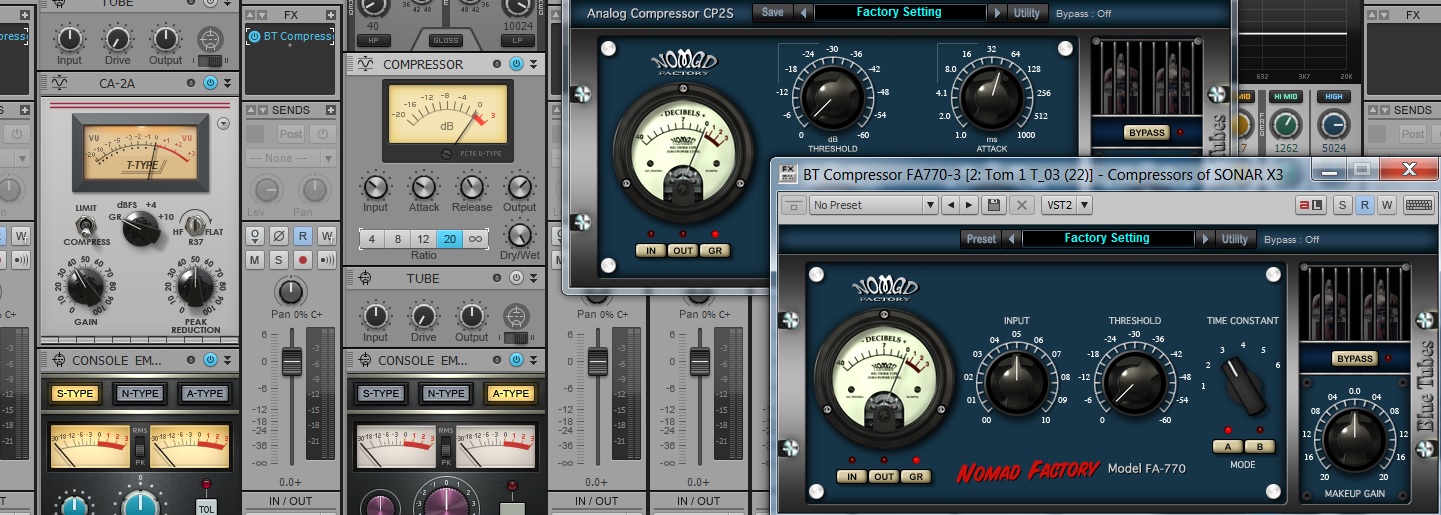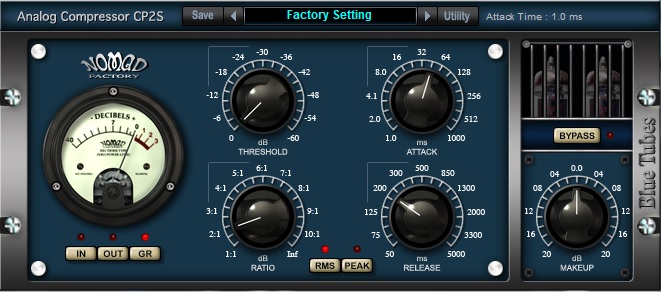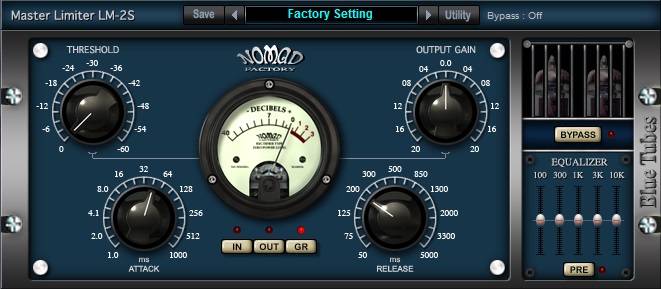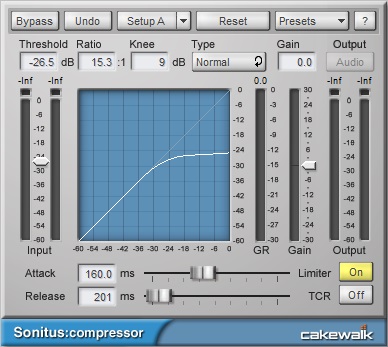What is Compression?

Compression is a massively useful tool for pro audio applications. As a simultaneous corrective and creative utility suitable for both tonal shaping and controlling levels, a compressor is one of the most important pieces of gear in your sonic toolbox.
Instead of explaining the history and value of knowing all the different types of compressors that exist, we’re just going to dive in and show you how to get results. Once you understand this you’ll be able to grasp the larger picture of compression and the many different circuits and types. SONAR X3 Studio & Producer come packed with quite a few different types of compressors, so let’s open them up and take a look.
PC76 U-Type
Modeled after one of the most classic leveling amplifiers in history, the PC76 U-Type is a go-to compressor for just about any situation – whether you’re looking to crush a signal beyond recognition, or just add a touch of level control. The creative benefits are endless, thanks to its peak limiting abilities and quick 100 microsecond attack time. Unlike the original hardware, our version even comes with a variable Wet/Dry knob. Use it for vocals, bass, drums, and acoustic guitar. Crush drum room microphones, ambient microphones, dialogue, and everything else you mult or clone.
PC4K S-Type

Based on a classic quad-bus compressor, the PC4K S-Type provides just the right amount of “glue” you need to throw across a single track or bus. This compressor is a great introduction to using compression for creative and corrective purposes because of its flexibility. Having a variable Threshold, Attack, Release, Gain, and Ratio allow a wide variety of sounds, from subtle to substantial. With the added sidechain it’s easy to apply ducking techniques (e.g., reducing level of one track in response to another track’s level) from anywhere in SONAR. Again, the added Wet/Dry knob makes for an immeasurable convenience as opposed to its hardware relative.
The most common use for this type of module is on a summing bus – a bus that combines multiple vocal, drum, horn, or guitar tracks, then sends the bus output to your master bus. You should have at least one per every group of instruments in your mix. Having the S-Type on that bus adds that glue that everyone often talks about when referring to this type of compressor by giving a gentle lift to the overall level, and providing more cohesiveness among the individual tracks so they sound more like they’re playing together. It’s commonly known that the best-sounding compression is the compression you can’t hear. For the summing bus case, subtle use of this module on several tracks ends up making a major improvement to your sound. You won’t realize this until you A/B your tracks with and without the compression.

Nomad Factory CP-2S
SONAR X3 bundles some supreme dyanmic effects from Nomad Factory’s arsenal of modeled analog audio devices. The CP-2S is a solid all-around digital compressor with an analog tone. Both Peak and RMS sensing are available so you can depend on this guy to help out in serial compression situations. Serial compression is a technique that controls highly dynamic/erratic audio signals. The common practice is placing an RMS sensing compressor on a track and then a peak sensing compressor right after it. RMS sensing averages the overall signal height of the audio before applying gain reduction, which results in a pretty “human-sounding” level control. The Peak sensing compressor squashes any large peaks that get through. Typically you need to go hunting for a separate RMS and Peak sensing compressor but with the CP-2S you just add a second instance and change the sensing mode – easy.
Nomad Factory FA-770
 Three words: vintage, vintage, and vintage. A true classic that stands out in SONAR’s pick of dynamic processors, the FA-770’s is influenced by hardware that goes back about 60 years, and became a staple for the dynamic processors that followed. This dynamic module can act as both a limiter and compressor, handling extreme peaks and pumping tracks. The fixed 12 Attack/Release settings aim to give you the best possible combinations for applying gain reduction. True to its heritage, there’s a fixed ratio – meaning there is no adjustment for ratio, which is set by the incoming decibel level and threshold setting. If it’s anything like its hardware ancestor then it means it operates between 2:1 and up to 30:1. Although a little more difficult to adjust, the more vintage you want to go with your sound, then the better this effect will be for you.
Three words: vintage, vintage, and vintage. A true classic that stands out in SONAR’s pick of dynamic processors, the FA-770’s is influenced by hardware that goes back about 60 years, and became a staple for the dynamic processors that followed. This dynamic module can act as both a limiter and compressor, handling extreme peaks and pumping tracks. The fixed 12 Attack/Release settings aim to give you the best possible combinations for applying gain reduction. True to its heritage, there’s a fixed ratio – meaning there is no adjustment for ratio, which is set by the incoming decibel level and threshold setting. If it’s anything like its hardware ancestor then it means it operates between 2:1 and up to 30:1. Although a little more difficult to adjust, the more vintage you want to go with your sound, then the better this effect will be for you.
Nomad Factory Brickwall Limiter
…and a brickwall it truly is. This dynamic module should have a nice place right at the end of your master bus taking out massive peaks as they come. This dedicated peak crusher adds a touch of analog distortion to your track as it passes through its algorithms. Adjust the variable release for harsh gain reduction, or open it up for a gentler recoil.
Nomad Factory LM-2S
 If you feel as if your overall mix could use some shaping then the LM-2S is the answer. This Limiter has the same sort of flexibility as the CP-2S but with a stronger fixed ratio. Applying this across your master bus is where it shines with the ability to control, tighten, or loosen your mix. Because it offers such a strong potential for gain reduction it’s more apt to react to low-level frequencies; so for final touches, there’s a small 5-band EQ that can be placed before or after it hits the main unit.
If you feel as if your overall mix could use some shaping then the LM-2S is the answer. This Limiter has the same sort of flexibility as the CP-2S but with a stronger fixed ratio. Applying this across your master bus is where it shines with the ability to control, tighten, or loosen your mix. Because it offers such a strong potential for gain reduction it’s more apt to react to low-level frequencies; so for final touches, there’s a small 5-band EQ that can be placed before or after it hits the main unit.
Sonitus Compressor
 A true Cakewalk classic, the Sonitus Compressor is representative of modern digital compressors that can lock in the perfect amount of control while adding little, if any, coloration if that’s what you want. The Sonitus differs from other Cakewalk compressors with its variable knee adjustments and useful visual feedback, making a first-timer’s life a bit easier – compression can be a confusing subject, so having a highly detailed visual aid makes all the difference. The Sonitus Compressor is well-suited to difficult compression tasks like bass – which can be an extremely troublesome when not played or tracked correctly. Transparency is key with compression, and the Sonitus delivers the feel of no particular compressor; it instead offers a clear amount of gain reduction, with the flexibility to mimic classic hardware designs.
A true Cakewalk classic, the Sonitus Compressor is representative of modern digital compressors that can lock in the perfect amount of control while adding little, if any, coloration if that’s what you want. The Sonitus differs from other Cakewalk compressors with its variable knee adjustments and useful visual feedback, making a first-timer’s life a bit easier – compression can be a confusing subject, so having a highly detailed visual aid makes all the difference. The Sonitus Compressor is well-suited to difficult compression tasks like bass – which can be an extremely troublesome when not played or tracked correctly. Transparency is key with compression, and the Sonitus delivers the feel of no particular compressor; it instead offers a clear amount of gain reduction, with the flexibility to mimic classic hardware designs.
Stay tuned for more information and tips about all the effects in SONAR with our DSP 101 tag.



